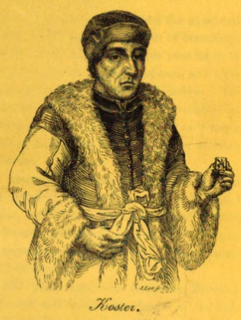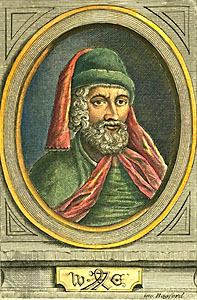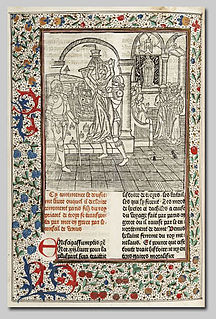
Laurens Janszoon Coster, or Laurens Jansz Koster, is the purported inventor of a printing press from Haarlem. He allegedly invented printing simultaneously with Johannes Gutenberg and was regarded by some in the Netherlands well into the 20th century as having invented printing first.

Rodolphus Agricola was a pre-Erasmian humanist of the Northern Low Countries, famous for his knowledge of Latin and Greek. He was an educator, musician, builder of church organs, a poet in Latin and the vernacular, a diplomat, a boxer and a Hebrew scholar towards the end of his life. Today, he is best known as the author of De inventione dialectica, the father of Northern European humanism and as a zealous anti-scholastic in the late fifteenth century.

Year 1535 (MDXXXV) was a common year starting on Friday of the Julian calendar.

Gouda is a city and municipality in the west of the Netherlands, between Rotterdam and Utrecht, in the province of South Holland. Gouda has a population of 72,338 and is famous for its Gouda cheese, stroopwafels, many grachten, smoking pipes, and its 15th-century city hall. Its array of historic churches and other buildings makes it a very popular day trip destination.

William Caxton was an English merchant, diplomat, and writer. He is thought to be the first person to introduce a printing press into England, in 1476, and as a printer was the first English retailer of printed books.
This article presents lists of the literary events and publications in the 15th century.

John Gerard was an English herbalist with a large garden in Holborn, now part of London. His 1,484-page illustrated Herball, or Generall Historie of Plantes, first published in 1597, became a popular gardening and herbal book in English in the 17th century. Except for some added plants from his own garden and from North America, Gerard's Herbal is largely a plagiarized English translation of Rembert Dodoens's 1554 herbal, itself highly popular in Dutch, Latin, French and other English translations. Gerard's Herball drawings of plants and the printer's woodcuts are mainly derived from Continental European sources, but there is an original title page with a copperplate engraving by William Rogers. Two decades after Gerard's death, the book was corrected and expanded to about 1,700 pages.

Christophe Plantin was a French Renaissance humanist and book printer and publisher who resided and worked in Antwerp.

Rembert Dodoens was a Flemish physician and botanist, also known under his Latinized name Rembertus Dodonaeus. He has been called the father of botany. The standard author abbreviation Dodoens is used to indicate this person as the author when citing a botanical name.
Hinrek van Alckmer, also known as Hendric van Alckmaer, Henrik van Alkmer and Henry of Alkmaar, was a 15th-century Middle Dutch author who wrote one of the principal published versions of Reynard the Fox in 1487.

Consolatio peccatorum, seu Processus Luciferi contra Jesum Christum is a tract written by Jacobus de Teramo in around 1382. This "consolation of sinners" is a lawsuit between Lucifer and Jesus Christ, Solomon presiding, in which the Devil is suing Christ for having trespassed by descending into Hell.

Anton Koberger was the German goldsmith, printer and publisher who printed and published the Nuremberg Chronicle, a landmark of incunabula, and was a successful bookseller of works from other printers. In 1470 he established the first printing house in Nuremberg. Koberger was the godfather of Albrecht Dürer, whose family lived on the same street.

Dirk Martens was a printer and editor in the County of Flanders. He published over fifty books by Erasmus and the very first edition of Thomas More's Utopia. He was the first to print Greek and Hebrew characters in the Netherlands. In 1856 a statue of Martens was erected on the main square of the town of his birth, Aalst.

Dialogus creaturarum, is a collection of 122 Latin-language fables and, as the title implies, dialogues of creatures. It was the first book ever printed in Sweden (1483).

Colard Mansion was a 15th-century Flemish scribe and printer who worked together with William Caxton. He is known as the first printer of a book with copper engravings, and as the printer of the first books in English and French.
Hendrik Herp, known in Latin as Henricus Harphius, was a Dutch or Flemish Franciscan of the Strict Observance, and a writer on mysticism.
Merten de Keyser was a 16th-century French printer and publisher working mainly in Antwerp, who printed the first complete French and the first complete English Bible translations as well as a number of works by English Protestant authors.

Solomon and Marcolf is a medieval narrative describing the adventures and conversations of Solomon and Marcolf, or Marolf. The adventures have some connection with those of Ashmedai, while the conversations consist chiefly of riddles similar to those put to Solomon by the Queen of Sheba. The exact extent of its indebtedness to the Haggadah is somewhat doubtful, though it is practically certain that the various versions are derived from an Eastern original.

Willem Vorsterman was an early printer of books, active in Antwerp between 1504 and 1543. He published about 400 books in Dutch, Spanish, English, Latin, French and Danish, making him the second most productive printer in the Netherlands in the first half of the 16th century, behind Hillenius. His earliest production, between 1500 and 1520, consisted mainly of works of fiction in Dutch often in chapbook format, while he later expanded into other languages and genres, with more luxurious, illustrated editions. He entered the Antwerp Guild of Saint Luke in 1512 and was its dean in 1527 and 1542. His shop was in the "Golden Unicorn", near the Kammerpoort in Antwerp.
Johann Veldener, also known as Jan Veldener or Johan Veldenaer; was an early printer in Flanders. He worked as a punchcutter and printer in Cologne, together with William Caxton, who may have financed his first books. They both left for Flanders in 1472. Evidence indicates that Veldener assisted Caxton in setting up his printing office in Bruges and helped printing his first work there, the 1472-1473 Recuyell of the Historyes of Troye by Raoul Lefèvre. Afterwards, Veldener went to Leuven and set up his printing company there, becoming the second printer in Leuven after John of Westphalia, and the third or fourth in the Netherlands. He entered the Leuven University on 30 July 1473 in the faculty of Medicine.















